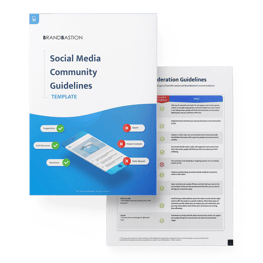
How to Respond to Online Hate Speech: A Guide from BrandBastion
Although we’ve all encountered it at some point in our lives, hate speech can be challenging to define. Because there is no international legal definition of the term, even the characterization of what is ‘hateful’ can sometimes be controversial and disputed.
According to the UN, the term ‘hate speech’ is understood as “any kind of communication in speech, writing or behavior, that attacks or uses pejorative or discriminatory language with reference to a person or a group on the basis of who they are, in other words, based on their religion, ethnicity, nationality, race, color, descent, gender or other identity factor.”
Taking into consideration that over 3 billion people are using social media (which is about half of the population on Earth), it is expected that a lot of hate speech is also happening across social media channels.
| Bonus: Download free Social Media Community Guidelines |
In May 2020, Facebook released its biannual Community Standards Enforcement Report, which showed that the company took action against more than 2 billion pieces of content violating its community standards. A surge in content that promotes hate and violence was particularly noticeable—Facebook deleted a record number of hate speech posts (9.6 million posts compared to 5.7 million in the prior period).
The sharp increase in hate speech removals was also attributed to Facebook’s technology improvements for automatically identifying images and text. In one of its statements, the company explained that “we’re now able to detect text embedded in images and videos in order to understand its full context, and we’ve built media matching technology to find content that’s identical or near-identical to photos, videos, text and even audio that we’ve already removed.”
But then most recently, The North Face became the first major brand (Unilever and Coca Cola followed with the same announcement) to boycott Facebook and stop buying Facebook ads in the US in solidarity with civil rights organizations such as the NAACP, the Anti-Defamation League, and Sleeping Giants. The company said it was demanding stricter policies against racist, violent, hateful content, and misinformation, from circulating on the platform.
According to Business Insider, an ad agency anticipated a number of other brands also walking out on Facebook. But the solidarity of brands with civil rights movements isn’t just a call for stricter policies—it is also a call for action and making social media a safer and more inclusive place for everyone.
For the past 6 years, BrandBastion has been helping brands improve their response to discrimination, profanity, brand attacks, spam, and many other types of harmful content across their paid and organic social media content.
Thanks to this valuable experience, we were able to put together the following suggestions on how brands and individuals should handle hate speech online.
How to respond to online hate speech as a brand
While dealing with hateful comments might seem difficult or even scary, brands should look at the bigger picture and understand that these situations can be a chance to protect their audience and show them they care about making social media a safe place.
The first rule of managing harmful content such as discrimination, profanity, personal attacks, spam, disturbing comments, and similar content online, is taking action.
Brands that ignore harmful comments on their social media are risking much more than those who choose to deal with them. The reason is simple: not reacting to a hateful comment can result in people thinking that the brand approves of it. And if picked up by media, just a few ignored harmful comments can turn into a PR disaster.
According to survey, 79% of users think that content that promotes violence and discrimination should be removed from social media. At BrandBastion, we suggest hiding harmful content rather than deleting it, as often deleting comments can cause more anger and lead to the author posting even more hateful content. Based on Facebook’s settings, when a comment is hidden on Facebook, only the author and their friends on Facebook can see the comment. On Instagram, when a brand chooses to hide a comment, the author is the only person who can see it.
It is also important to note that hiding online hate speech and limiting someone’s freedom of speech online isn’t the same thing. Free speech or freedom of expression is defined as the right to seek, receive and impart information and ideas of all kinds, either orally, in writing, or through any other media. The exercise of this right carries certain duties and responsibilities and may, therefore, be subject to certain restrictions. These restrictions should only be provided by law—for example, governments have an obligation to prohibit hate speech and incitement. Restrictions can also be justified if they protect specific public interest or the rights and reputations of other people.
Because determining what types of harmful comments should be hidden can be difficult, we decided to create a simple checklist that will help you identify different types of harmful comments and how to respond to them properly.
Download BrandBastion’s checklist to learn how to deal with different types of harmful comments.
How to respond to online hate speech as an individual
At BrandBastion, we believe that taking action is crucial for making things better. Here’s what each of us can do as an individual to take action and become more efficient at responding to online hate speech.
1. Understand online hate speech
As strange as it may sound, the first reaction to hate speech online should be to understand that there is a human being on the other side of the screen. As Dylan Marron explains it in his TED talk, we can develop empathy for people who are saying bad things about us or someone else, without justifying their words.
This approach helps us realize that the authors of hate speech are just individuals and not the voice of the majority. By humanizing people who are spreading online hate, we take away the power they have over us.
“Empathy is just the acknowledgment that someone is human,” Dylan explained. “But it can feel really weird to empathize with someone who you really disagree with or who very much disagrees with a very core part of you and who you are. We are scared to empathize with people because we’re scared that empathizing with them props up their point.”
2. Take a stand by setting a positive example
Hateful discussions on the internet often escalate very quickly. When people argue online, they may quickly start offending everyone who doesn’t think like them. What you can do in this situation is to disagree respectfully with those who are spreading hateful comments. Try to respect the viewpoints of those you disagree with and explain why you believe this is wrong.
Speaking truth without offending others is crucial in these situations because it sets a positive example for others as well. It helps them learn new information, told from another person’s point of view, which is often a fresh approach in threads packed with hateful content.
3. Report hate speech
While social media platforms are committed to removing hateful comments, this doesn’t happen automatically. One of the things that you can do as an individual is to report a hateful message when you see it. Based on your report, social media platforms can decide to remove the harmful content or even temporarily block the account.
Of course, not all hateful comments on the internet happen on social media. Have in mind that most websites have a moderator who is responsible for everything that is posted on that page, including the comments. The moderators also have the power to delete the harmful comments and send users a warning or even ban them from the site.
4. Raise awareness about hate speech
Hate speech is a real problem. The first step towards fighting the problem is acknowledging its existence. Raise awareness of the consequences of online hate speech in the real world. Share your experiences with online hate speech with your friends and family and support those who were or still are targets of hurtful comments.
During difficult times like these, what matters the most is taking action and standing up to hate. And no matter how big or small our impact is, doing something is always a better option because when we do nothing, we become a part of the problem.
5. Ask your favorite communities and groups to take action
If you are a member of a Facebook group, a community, or you’ve been actively involved with a brand online, and you notice harmful comments within a group or community, make sure you contact the admin and ask them to enforce community management guidelines.
And if that community doesn’t already have clearly defined community guidelines, here’s a free template you can use or share with your favorite brand on social media to make sure everyone knows that online hate speech will not be tolerated:
Welcome to the [brand] community! This is a safe space to discuss [brand/values/products].
We encourage feedback and we will respond to your comments and inquiries as soon as possible.
While we encourage open discussion, this community will be moderated to make everyone feel safe and included. To help everyone enjoy the time they spend in our community, we ask that when you post, you keep in mind the following:
- We don’t allow offensive, indecent, discriminatory, or threatening comments.
- Personal attacks, trolling, abuse, and spamming will not be tolerated.
- We reserve the right to delete comments at our discretion and block any repeat offenders.
- We recommend that you don’t post information that may identify you or anyone else (such as you address, email address, phone number, etc.) as this is a public place.
6. Reach out to supportive organizations if you are being abused online
If you are experiencing online hate speech, personal attacks, or any form of online harassment, here are a few resources you can reach out to and get help:
Get Safe Online offers information about how to recognize and deal with cyberbullying, cyberstalking, trolling, and other forms of online abuse. The organization also offers helplines and email addresses you can use to get help in case you find yourself in one of these situations.
7 cups is an online support platform that offers free emotional support, affordable online therapy and counseling for anyone who is experiencing online harassment.
The Cybersmile Foundation offers help and education for all online abuse-related problems. The organization also has a support account launched in partnership with Twitter which is an official Twitter trusted resource that shares useful and informative content related to online security and safety.
Are you looking for a solution that could help your brand to respond better on social media? We’re here and we’re listening.
Download free Social Media Community Guidelines

